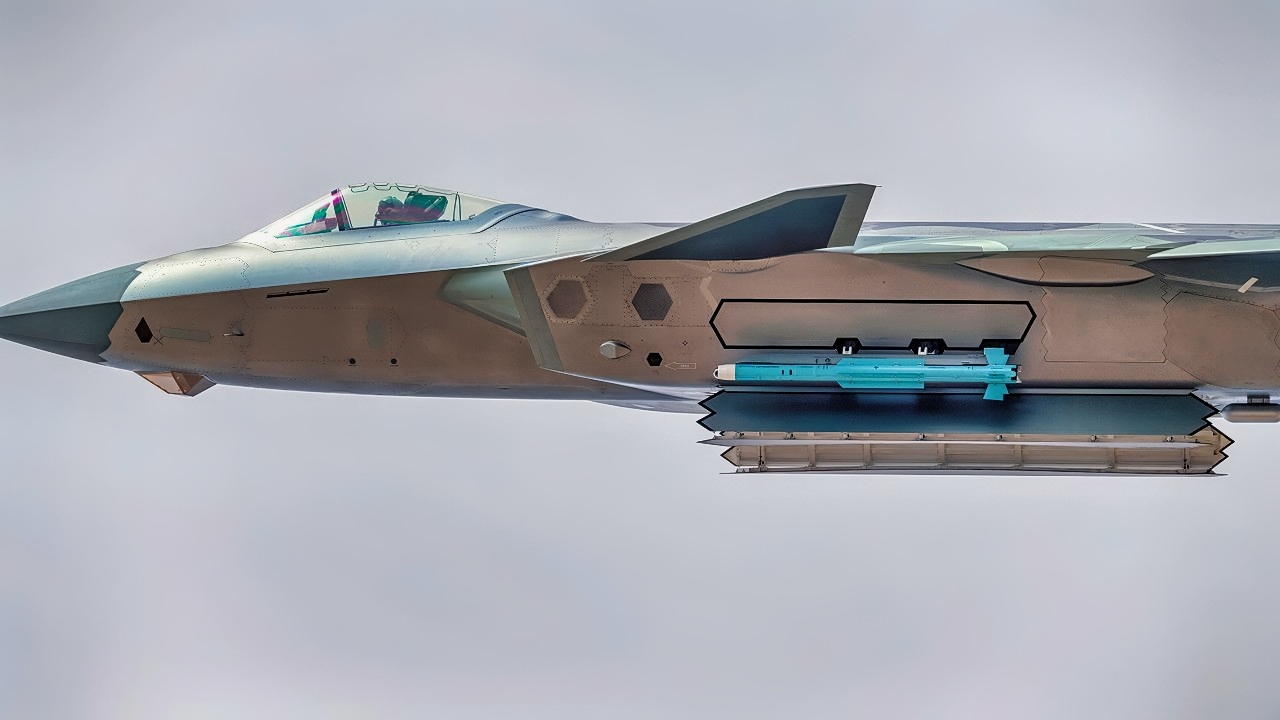Key Points and Summary – Making its first flight in 2011, the Chengdu J-20 “Mighty Dragon” shocked the world and proclaimed China’s place as a near-competitor with the U.S. in the realm of aerospace engineering.
-Since its inception, the J-20 has undergone several upgrades, from its powerpack to its radar suite, making it deadlier and more formidable with each addition.
-One aspect that makes it so formidable is its deadly arsenal of air-to-air and air-to-ground missiles, which can be stored in either the internal weapons bays or its external hardpoints.
The J-20’s Deadly Arsenal
The J-20 is equipped to carry a wide array of weapons, most of which are housed internally to preserve its stealth characteristics. The main internal weapons bay can accommodate four to six PL-15 long-range air-to-air missiles, which are among the most advanced in China’s arsenal. These missiles are believed to have a range exceeding 200 kilometers and are guided by active radar homing.
On each side of the fuselage, the J-20 has smaller bays that typically carry one PL-10 short-range infrared-guided missile each. The PL-10 is designed for close-range dogfighting and features high off-boresight targeting capabilities.
When stealth is not a priority, the J-20 can utilize four external hardpoints under its wings. These can be used to carry additional PL-15 missiles, auxiliary fuel tanks, or precision-guided munitions such as the LS-6 series bombs.
The aircraft’s total payload capacity is estimated to be around 11,000 kilograms, allowing it to carry a mix of air-to-air missiles, air-to-ground weapons, and potentially anti-radiation missiles.
Notably, the J-20 does not include an internal autocannon, which suggests a doctrinal emphasis on long-range engagements rather than close-in dogfighting.
The Mighty Dragon vs the Americans
Compared to its American counterparts, the J-20 faces significant competition.
The F-22 Raptor, for example, is able to carry around 15,000kg of armaments if utilizing its external hardpoints. It has three internal weapons bays, the largest of which can carry up to six air-to-air missiles.
Additionally, the F-22 has four external hardpoints, each capable of carrying up to 5,000 pounds of weapons. The F-22 carries a mix of AIM-120 and AIM-9X missiles internally, while the J-20 relies on the PL-15 and PL-10.
The PL-15 is believed to have a more extended range than the AIM-120D, which could give the J-20 an edge in beyond-visual-range engagements. In terms of total weapons capacity, however, the F-22 is superior overall.
The F-35, on the other hand, has a smaller payload than the J-20, but it makes up for it with greater versatility. Overall, it can carry up to 8,160kg of weapons internally and externally, which is around 18,000 lbs. In addition to a wide range of air-to-air and air-to-ground missiles, the F-35 can carry laser-guided bombs like JDAMs and AGM-154 JSOW bombs.
Additionally, work is underway to incorporate anti-ship missiles, such as the AGM-158C LRASM and the Joint Strike Missile. While the J-20 has a larger payload capacity, the F-35’s ability to operate in a wide range of mission profiles and its integration into allied networks make it a formidable platform.
Development of the J-20
The development of the J-20 began in the late 1990s under the J-XX program, with its first flight occurring in January 2011.
It officially entered service in 2017 and has since undergone several upgrades. The aircraft features a distinctive canard-delta wing configuration, diverterless supersonic inlets (DSI), and a blended fuselage that contributes to its stealth profile. These design elements, along with radar-absorbing materials and internal weapon bays, help reduce its radar cross-section and enhance survivability in contested environments.
The J-20’s performance is bolstered by its evolving engine technology. Initially powered by Russian AL-31 engines, the aircraft now uses domestically produced WS-10C engines, with future variants expected to incorporate the more powerful WS-15.
The WS-15 is designed to provide supercruise capability and thrust vectoring, which would significantly enhance maneuverability. The J-20 is capable of reaching speeds up to Mach 2.8 and can supercruise at approximately Mach 1.8. Its combat radius is estimated to be around 1,700 kilometers, giving it a substantial reach for operations over the East and South China Seas.
China’s Best Stealth Fighter (For Now)
Avionics and sensor systems on the J-20 are state-of-the-art. It is equipped with an active electronically scanned array (AESA) radar that can detect targets at ranges exceeding 350 kilometers.
The aircraft also features an electro-optical targeting system (EOTS), a distributed aperture system (DAS), and infrared search and track (IRST) capabilities.
These systems provide the pilot with comprehensive situational awareness and enable passive detection of enemy aircraft. The cockpit is outfitted with a digital glass interface, a wide-angle heads-up display (HUD), and a helmet-mounted display system, allowing for advanced targeting and information management.
The J-20 is part of China’s strategy to challenge U.S. air dominance and establish a credible deterrent in the Indo-Pacific region.
Its long-range capabilities, stealth, and advanced sensors make it well-suited for anti-access/area denial (A2/AD) operations, long-range interception, and electronic warfare.
The deployment of the J-20 across all five Chinese theater commands and its increasing presence in patrols over contested areas signal its growing operational importance.
About the Author:
Isaac Seitz, a Defense Columnist, graduated from Patrick Henry College’s Strategic Intelligence and National Security program. He has also studied Russian at Middlebury Language Schools and has worked as an intelligence Analyst in the private sector.
Military Affairs
China’s Stealth Air Force Has 1 Mission










